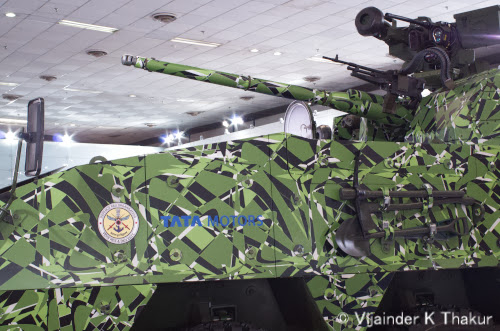Tata Motor's Kestrel APC unveiled at DefExpo 2014.
Tata Motors was one of several Indian and foreign countries invited by Vehicle Research & Development Establishment (VRDE), a unit of DRDO, to respond to a request for information (RFI) for the supply of chasis, propulsion unit and weapon system for a wheeled armored amphibious platform. Other Indian firms invited to bid included L&T and Mahindra & Mahindra, while Russia's Rosoboronexport was among the foreign companies invited.
Tata responded to the RFI, and later to the RFP, for all the three modules of the armored personnel carrier (APC), and went on to win the three contracts. After being awarded the contract, the company shocked DRDO by developing the entire platform in just 18 months. (Tata's alacrity in developing the APC, despite its past manufacturing experience being limited to automotive products, may well be the reason why no one ever heard of the Kestrel till a few days before DefExpo 2014. The development time frame was bound to show the DRDO in poor light! I an only half kidding!)
The Kestrel, which is 7.8-m long and 2.28-m wide has a crew of 2 and can additionally carry 10 armed soldiers.
Kestrel's ballistic protection is modular. The protection modules can be replaced at short notice in response to varying threat levels, ranging from Stanag 1 to Stanag 4.
On land, it has a max speed of 100-kph. When in water, it uses two underwater jets to wade through at up to 10-kph.
Powered by a 600-hp engine, it has a Power/Wt. ratio of between 26.6 to 23.
Note the rear view mirror on the amphibious APC!
The APC is armed with a 30-mm remotely operated cannon, a single 7.62-mm co-axial MMG and an automatic grenade launcher. In addition, it's capable of being fitted with a Javelin anti-tank missile station. The vehicle can be optimized for riverine, mountain or desert terrain.
The weapon fit of the vehicle hasn't been firmed up and will depend on user requirement. Tata is relying on the modularity and open architecture of the vehicle to make it suitable for diverse roles.
The Indian Army has shown a lot of interest in the vehicle and wants to get involved in the project before the configurations are locked down.
All the main subsystems of the Kestrel share commonality with in service Tata standard vehicle aggregates, so maintenance of the vehicle less expensive than foreign APCs.






No comments:
Post a Comment